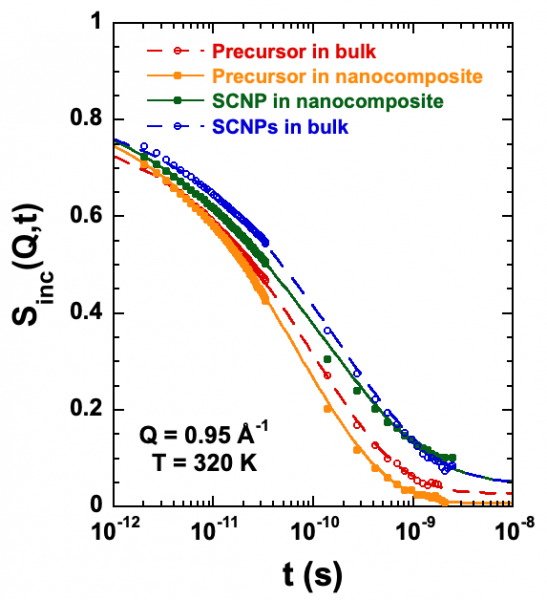Disentangling Component Dynamics in an All-Polymer Nanocomposite based on Single-Chain Nanoparticles by means of Quasielastic Neutron Scattering
One of the first envisaged applications for Single-Chain Nano-Particles (SCNPs) was as ‘fillers’ of nano-composites due to the tunability of their size, interactions and dynamic asymmetry with the matrix. Unveiling the mutual influence of the components at a microscopic level is a challenge that can be faced by Quasielastic Neutron Scattering (QENS) techniques together with isotopic labeling.
This combination was applied to an all-polymer nanocomposite consisting of 25% SCNPs in a 75% polymer matrix composed by the linear precursor chains of the SCNPs. Two spectrometers were combined to cover a wide dynamic range and properly characterize the complex dynamics of both components in the mixtures. In the raw materials –investigated as reference–, the intra-molecular crosslinks induce a slowing down and a broadening of the dynamic response of the SCNPs with respect to the reference precursors. Dynamic asymmetry is also patent in the nanocomposite. The QENS experiments revealed the development of a dynamic heterogeneity in the nanocomposite components, which grows with increasing time: while the picosecond dynamics of precursor and SCNPs are very similar, they become more and more distinct at longer times. The more retarded dynamics of the SCNPs with respect to the linear chains would be related with the relaxation of the internal loops in the SCNPs as argued for the SCNPs in the bulk. This is the mechanism which determines the final relaxation at long times. In the nanocomposite, the displacements of SCNPs’ hydrogens display enhanced deviations from Gaussian and exponential behavior compared with the pure melt of SCNPs. These effects would be due to the speed up of the motions of the SCNPs at short times induced by the surrounding faster linear precursor dynamics. On the other hand, the motions in the linear matrix are faster than in the bulk precursor material –an a priori unexpected result. These combined effects result in an averaged behavior that coincides with that of the pure precursor. This observation is in accordance with the macroscopic finding by DSC experiments –from which no impact of the presence of SCNPs on the material with respect to the pure matrix dynamics is deduced. This study demonstrates the power of QENS combined with isotopic labeling to selectively characterize component dynamics at microscopic level in complex materials like all-polymer nanocomposites, and resolve subtle effects that are overlooked by macroscopic non-selective methods.
This microscopic and selective insight reveals the crucial role of the relaxation of the internal loops of the SCNPs, that induces an increase with time of the dynamic heterogeneity in the nanocomposite.

Figure 1: Schematic illustration of all-polymer nanocomposite composition.

Figure 2: Fourier-transformed and deconvoluted QENS spectra of the precursor and SCNPs in their respective bulk materials (empty circles) and as components in the nanocomposites (full squares).



